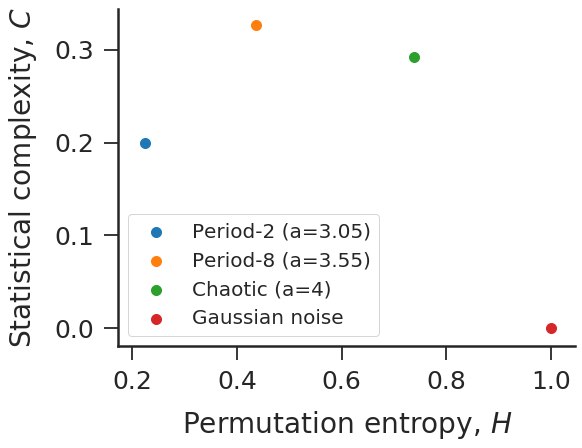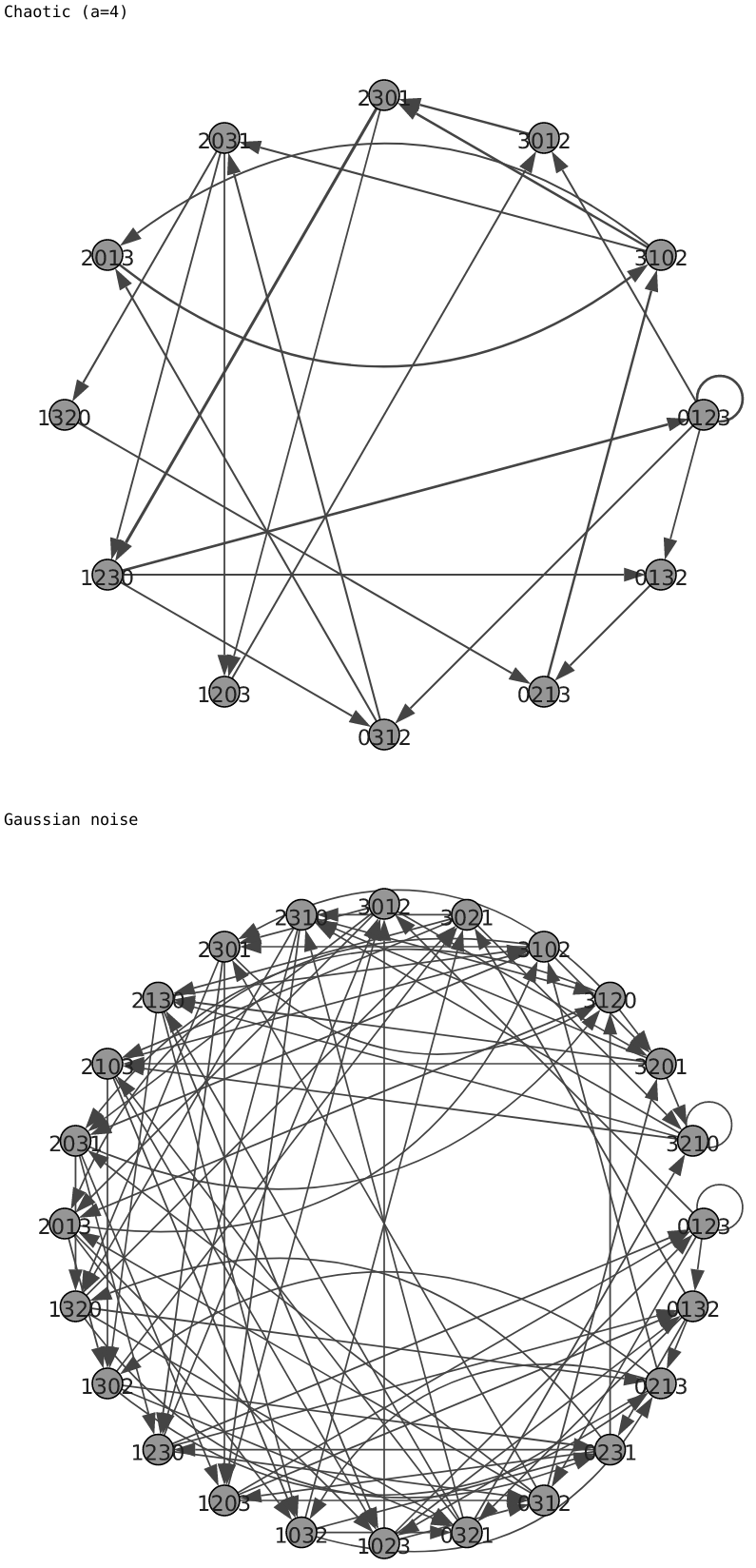ordpy is a pure Python module [1] that implements data analysis methods based
on Bandt and Pompe's [2] symbolic encoding scheme.
If you have used ordpy in a scientific publication, we would appreciate citations to the following reference [1]:
- A. A. B. Pessa, H. V. Ribeiro, ordpy: A Python package for data analysis with permutation entropy and ordinal network methods, Chaos 31, 063110 (2021).
@misc{pessa2021ordpy,
title = {ordpy: A Python package for data analysis with permutation entropy and ordinal network methods},
author = {Arthur A. B. Pessa and Haroldo V. Ribeiro},
journal = {Chaos: An Interdisciplinary Journal of Nonlinear Science},
volume = {31},
number = {6},
pages = {063110},
year = {2021},
doi = {10.1063/5.0049901},
}ordpy implements the following data analysis methods:
- Permutation entropy for time series [2] and images [3];
- Complexity-entropy plane for time series [4], [5] and images [3];
- Multiscale complexity-entropy plane for time series [6] and images [7];
- Tsallis [8] and Rényi [9] generalized complexity-entropy curves for time series and images;
- Ordinal networks for time series [10], [11] and images [12];
- Global node entropy of ordinal networks for time series [13], [11] and images [12].
- Missing ordinal patterns [14] and missing transitions between ordinal patterns [11] for time series and images.
For more detailed information about the methods implemented in ordpy, please
consult its documentation.
Ordpy can be installed via the command line using
pip install ordpyor you can directly clone its git repository:
git clone https://github.com/arthurpessa/ordpy.git
cd ordpy
pip install -e .We provide a notebook
illustrating how to use ordpy. This notebook reproduces all figures of our
article [1]. The code below shows simple applications of ordpy.
#Complexity-entropy plane for logistic map and Gaussian noise.
import numpy as np
import ordpy
from matplotlib import pylab as plt
def logistic(a=4, n=100000, x0=0.4):
x = np.zeros(n)
x[0] = x0
for i in range(n-1):
x[i+1] = a*x[i]*(1-x[i])
return(x)
time_series = [logistic(a) for a in [3.05, 3.55, 4]]
time_series += [np.random.normal(size=100000)]
HC = [ordpy.complexity_entropy(series, dx=4) for series in time_series]
f, ax = plt.subplots(figsize=(8.19, 6.3))
for HC_, label_ in zip(HC, ['Period-2 (a=3.05)',
'Period-8 (a=3.55)',
'Chaotic (a=4)',
'Gaussian noise']):
ax.scatter(*HC_, label=label_, s=100)
ax.set_xlabel('Permutation entropy, $H$')
ax.set_ylabel('Statistical complexity, $C$')
ax.legend()#Ordinal networks for logistic map and Gaussian noise.
import numpy as np
import igraph
import ordpy
from matplotlib import pylab as plt
from IPython.core.display import display, SVG
def logistic(a=4, n=100000, x0=0.4):
x = np.zeros(n)
x[0] = x0
for i in range(n-1):
x[i+1] = a*x[i]*(1-x[i])
return(x)
time_series = [logistic(a=4), np.random.normal(size=100000)]
vertex_list, edge_list, edge_weight_list = list(), list(), list()
for series in time_series:
v_, e_, w_ = ordpy.ordinal_network(series, dx=4)
vertex_list += [v_]
edge_list += [e_]
edge_weight_list += [w_]
def create_ig_graph(vertex_list, edge_list, edge_weight):
G = igraph.Graph(directed=True)
for v_ in vertex_list:
G.add_vertex(v_)
for [in_, out_], weight_ in zip(edge_list, edge_weight):
G.add_edge(in_, out_, weight=weight_)
return G
graphs = []
for v_, e_, w_ in zip(vertex_list, edge_list, edge_weight_list):
graphs += [create_ig_graph(v_, e_, w_)]
def igplot(g):
f = igraph.plot(g,
layout=g.layout_circle(),
bbox=(500,500),
margin=(40, 40, 40, 40),
vertex_label = [s.replace('|','') for s in g.vs['name']],
vertex_label_color='#202020',
vertex_color='#969696',
vertex_size=20,
vertex_font_size=6,
edge_width=(1 + 8*np.asarray(g.es['weight'])).tolist(),
)
return f
for graph_, label_ in zip(graphs, ['Chaotic (a=4)',
'Gaussian noise']):
print(label_)
display(SVG(igplot(graph_)._repr_svg_()))Pull requests addressing errors or adding new functionalities are always welcome.
| [1] | (1, 2, 3) Pessa, A. A. B., & Ribeiro, H. V. (2021). ordpy: A Python package for data analysis with permutation entropy and ordinal networks methods. Chaos, 31, 063110. |
| [2] | (1, 2) Bandt, C., & Pompe, B. (2002). Permutation entropy: A Natural Complexity Measure for Time Series. Physical Review Letters, 88, 174102. |
| [3] | (1, 2) Ribeiro, H. V., Zunino, L., Lenzi, E. K., Santoro, P. A., & Mendes, R. S. (2012). Complexity-Entropy Causality Plane as a Complexity Measure for Two-Dimensional Patterns. PLOS ONE, 7, e40689. |
| [4] | Lopez-Ruiz, R., Mancini, H. L., & Calbet, X. (1995). A Statistical Measure of Complexity. Physics Letters A, 209, 321-326. |
| [5] | Rosso, O. A., Larrondo, H. A., Martin, M. T., Plastino, A., & Fuentes, M. A. (2007). Distinguishing Noise from Chaos. Physical Review Letters, 99, 154102. |
| [6] | Zunino, L., Soriano, M. C., & Rosso, O. A. (2012). Distinguishing Chaotic and Stochastic Dynamics from Time Series by Using a Multiscale Symbolic Approach. Physical Review E, 86, 046210. |
| [7] | Zunino, L., & Ribeiro, H. V. (2016). Discriminating Image Textures with the Multiscale Two-Dimensional Complexity-Entropy Causality Plane. Chaos, Solitons & Fractals, 91, 679-688. |
| [8] | Ribeiro, H. V., Jauregui, M., Zunino, L., & Lenzi, E. K. (2017). Characterizing Time Series Via Complexity-Entropy Curves. Physical Review E, 95, 062106. |
| [9] | Jauregui, M., Zunino, L., Lenzi, E. K., Mendes, R. S., & Ribeiro, H. V. (2018). Characterization of Time Series via Rényi Complexity-Entropy Curves. Physica A, 498, 74-85. |
| [10] | Small, M. (2013). Complex Networks From Time Series: Capturing Dynamics. In 2013 IEEE International Symposium on Circuits and Systems (ISCAS2013) (pp. 2509-2512). IEEE. |
| [11] | (1, 2, 3) Pessa, A. A. B., & Ribeiro, H. V. (2019). Characterizing Stochastic Time Series With Ordinal Networks. Physical Review E, 100, 042304. |
| [12] | (1, 2) Pessa, A. A. B., & Ribeiro, H. V. (2020). Mapping Images Into Ordinal Networks. Physical Review E, 102, 052312. |
| [13] | McCullough, M., Small, M., Iu, H. H. C., & Stemler, T. (2017). Multiscale Ordinal Network Analysis of Human Cardiac Dynamics. Philosophical Transactions of the Royal Society A, 375, 20160292. |
| [14] | Amigó, J. M., Zambrano, S., & Sanjuán, M. A. F. (2007). True and False Forbidden Patterns in Deterministic and Random Dynamics. Europhysics Letters, 79, 50001. |
| [15] | Martin, M. T., Plastino, A., & Rosso, O. A. (2006). Generalized Statistical Complexity Measures: Geometrical and Analytical Properties, Physica A, 369, 439–462. |




